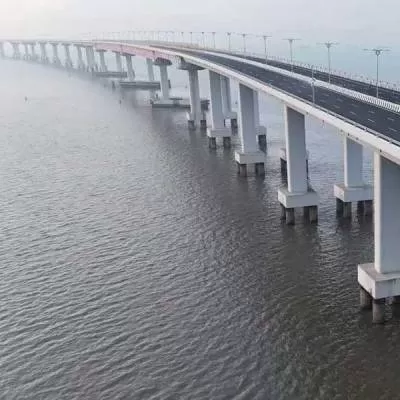- Home
- Infrastructure Transport
- ROADS & HIGHWAYS
- Step by Step

Step by Step
<span style="font-weight: bold;">Using the case of the Signature Bridge in New Delhi, ANAND SHAH explains the workings of a project management system.</span><br /> <br /> Wazirabad Barrage is one of the seven major links across the river Yamuna connecting eastern and western Delhi with a two-lane carriageway for the bridge segment. <p></p> <p>Indeed, the functional importance of the road in terms of connectivity to the eastern part of the city as well as various parts of Uttar Pradesh is significant. </p> <p>Not surprisingly, the barrage is crowded with a high volume of traffic almost throughout the day. This heavy traffic on the bridge is causing congestion, leading to greater travel time and a higher rate of accidents as well as increased fuel consumption, vehicle operating costs and air and noise pollution. </p> <p>Besides the barrage, the pontoon bridge located about 800 m downstream caters to the needs during the fair weather months but is dismantled during the monsoon. Considering the large recurring annual dismantling and assembly costs and maintenance cost, the feasibility of retaining the same is doubtful.</p> <p> <span style="font-weight: bold;">The need for a new bridge</span><br /> Thus, a second Wazirabad Bridge - Signature Bridge - was conceived to ease traffic congestion and save travel time and vehicle operation costs. </p> <p>Keeping in view the dispersal and circulation of traffic on both sides, the proposed east-west corridor over river Yamuna will cater to the need of commuters from the fast-developing areas of Yamuna Vihar, Gokul Puri and Nand Nagri, and inter-state traffic from Ghaziabad, Shahibabad and Loni on the eastern side, and Timarpur, Azadpur, Burari, Mukherjee Nagar, Mall Road, etc, on the western side. </p> <p>The construction of the proposed link will also call for improvement of key intersections within the influence area, which has been considered from Majnu ka Tila to Khajuri Khas intersection. This will help to facilitate smooth movement of traffic across the river and remove bottlenecks at the intersections within the vicinity.</p> <p> <span style="font-weight: bold;">Aims and objectives</span><br /> For the project management team, the aim was to evaluate and achieve the following:<br /> </p> <ul> <li>Technical consideration for the best location for the proposed bridge so it has minimum width of the waterway.</li> <li>Merging and diverging traffic and its impact on the intersection at Khajuri Khas and Wazirabad.</li> <li>Smooth and uninterrupted traffic flow on the proposed bridge as well as along the Ring Road from Azadpur to ISBT.</li> <li>Causing minimum environmental impact owing to the construction of the proposed bridge and approaches. </li> <li>Keeping rehabilitation and resettlement to a minimum</li> <li>Keeping land acquisition for the approach roads to a minimum.</li> <li>Try to minimise dislocation of utilities.</li></ul><br /> <span style="font-weight: bold;"> Studies conducted</span><br /> The project was assessed technically and economically in terms of feasibility and the following studies were conducted:<br /> Project topography: Three varied landscapes constitute the topography of the project:<br /> (a) River portion: Utilised for water storage works. <br /> (b) Ecological infrastructure: Walkways, amphitheatres, parks, etc.<br /> (c) Reserve forest area: Bio park and meandering walkways that will help generate revenue through tourism.<br /> Existing and proposed structures on bridge: The present approaches of Wazirabad barrage and bridge are inadequate at the service level and, therefore, there is a dire need for new infrastructure.<br /> Time-distance analysis between eastern and western approach:<br /> (a) Existing bridge: Time taken - 17 minutes; Distance - 5.2 km.<br /> (b) New bridge: Time taken - 12 minutes; Distance - 3.65 km.<br /> Cost-benefit analysis: Worked out in terms of:<br /> (a) Manpower saved.<br /> (b) Fuel saved.<br /> (c) Carbon credits earned.<br /> Development stage: The development stage of the project included a detailed analysis of the processes that are prerequisites to start the construction of any project. <br /> Tender document preparation and contract framing: Delhi Tourism and Transportation Development Corporation (DTTDC) prepared the tender document and set guidelines to prepare tender drawings and create a schedule of quantities. After award of the tender, the budget was revised to reaffirm the economics. After finalisation of the budget, Gammon was selected as the contractor to execute the project based on revised guidelines and final drawings.<br /> <p>Project planning and seeking of approvals: An S curve was prepared based on the project milestones set in the contract document as a measure to gauge progress of work within time. Parallel land acquisition process, technical permissions and approvals were sought. On completion of these activities, the contractor took up formalities for resource mobilisation for the project, including equipment, labour and other liabilities such as establishing labour camps, setting up a laboratory, soil investigation, etc.</p> <p> <span style="font-weight: bold;">Implementation stage</span><br /> Required infrastructure such as electricity, labour housing, water supply and tools, equipment and plants (TEP) were set up, and roles and responsibilities defined at the start of the implementation phase. Quality management and inspection plans were prepared. </p> <p>For material selection and procurement, ABC analysis and lead time analysis were performed. A specific purchasing policy and a comprehensive safety policy were devised for evaluation, selection of a vendor, store management and safety, respectively. </p> <p> Equipment management, project scheduling, budgeting, billing, labour, human resource management, etc, were monitored effectively via management information systems (MIS). </p> <p> <span style="font-weight: bold;">Commissioning stage</span><br /> The objective of commissioning is to provide documented confirmation that the scope of work of the project has been fulfilled as per requirements. To reach this goal, it is necessary for the commissioning process to establish and document the CPWD criteria for system function, performance and maintainability; as well as to verify and document compliance with these criteria throughout design, construction and operation. </p> <p>For the process to work successfully, it is important that the DTTDC, commissioning provider, design team, Gammon, and operators work together as a team throughout their involvement with the project. The contractor shall pre-commission, commission and carry out performance tests on the works listed in the description of works in the bid package. </p> <p> A pre-commissioning or commissioning activity shall be considered to be complete only when it has been witnessed, and the procedure and results of successfully carrying out that procedure have been signed off on by both the contractor and the company. The company may also require the vendor's representative to witness and sign the document.</p> <p>During all the pre-commissioning and commissioning activities, the contractor shall involve the company's operating staff (nominated by the company) and impart necessary techniques and knowhow required for operation and maintenance of the facilities.</p> <p>Thus, every stage of the project management process must be carried out meticulously to ensure the eventual success of the project.</p> <p> <span style="font-weight: bold;">About the author: Anand Shah</span> is part of the faculty of technology at CEPT University, Ahmedabad</p> <p> To share your views on this article, write in at feedback@ConstructionWorld.in</p> <p></p>




















